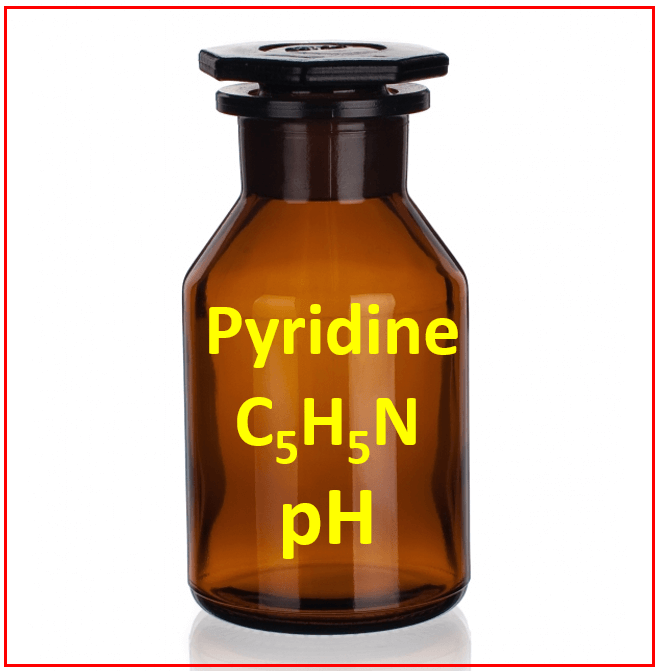What is the pH of a 0.650 M solution of pyridine? Kb = 1.5 × 10-9
Pyridine is a weak base and the first step is to write the reaction of the weak base with water. The formula of pyridine is C5H5N, so we can write:
C5H5N(aq) + H2O(l) ⇆ C5H5N-H+(aq) + OH–(aq)
If you didn’t know the formula of pyridine, you could just write Py or B (base):
Py (aq) + H2O(l) ⇆ Py-H+(aq) + OH–(aq)
Next, assume x mol/l C5H5N has reacted and set up an ICE table. Initially, the concentration of C5H5N is 0.650 M, and its equilibrium concentration is going to be decreased by x mol/l, so it is (0.650 – x) M.
The initial concentration of C5H5N-H+ and OH– ions is 0, and at equilibrium, they are going to be x mol/l because that is how much of the ammonia reacts with water.
|
|
[NH3] |
[C5H5N-H+] |
[OH–] |
|
Initial |
0.650 |
0 |
0 |
|
Change |
-x |
+x |
+x |
|
Equil |
0.650 – x |
x |
x |
The expression for the equilibrium constant will then be:
\[{K_{\rm{b}}}\;{\rm{ = }}{\mkern 1mu} \frac{{{\rm{[}}{{\rm{C}}_{\rm{5}}}{{\rm{H}}_{\rm{5}}}{\rm{N – }}{{\rm{H}}^{\rm{ + }}}{\rm{][O}}{{\rm{H}}^{\rm{ – }}}{\rm{]}}}}{{{\rm{[}}{{\rm{C}}_{\rm{5}}}{{\rm{H}}_{\rm{5}}}{\rm{N]}}}}\;{\rm{ = }}\;\frac{{{{\rm{x}}^{\rm{2}}}}}{{{\rm{0}}{\rm{.650}}\;{\rm{ – }}\;{\rm{x}}}}\;{\rm{ = }}\;{\rm{1}}{\rm{.5 \times 1}}{{\rm{0}}^{{\rm{ – 9}}}}\]
This is a quadratic equation and remember a short way of solving it to use an approximation that 0.650 – x ≈ 0.650 because the ionization constant of the weak is very small and therefore, the percentage of it reacted with water is negligible compared to its initial concentration.
By doing so, we get a simplified equation:
\[\frac{{{{\rm{x}}^{\rm{2}}}}}{{{\rm{0}}{\rm{.650}}}}\;{\rm{ = }}\;{\rm{1}}{\rm{.5 \times 1}}{{\rm{0}}^{{\rm{ – 9}}}}\]
Therefore, x = 3.12 x 10-5
Make sure the approximation is valid, and for this, x must be less than 5% of pyridine’s initial concentration:
\[\frac{{{\bf{3}}.{\bf{12}}{\rm{ }}{\bf{x}}{\rm{ }}{\bf{1}}{{\bf{0}}^{ – {\bf{5}}}}}}{{{\rm{0}}.{\rm{650}}}}\; \times \;100\% {\rm{\;}} = \;0.0048\% {\rm{\;}}\]
Therefore, the approximation was valid and the concentration of OH– ion is 3.12 x 10-5 M and we can calculate the pOH:
pOH = -log [-OH] = -log 3.12 x 10-5 = 4.51
And finally, we can calculate the pH using the pH and pOH correlation:
pH =14 – pOH = 14 – 4.51 = 9.49
Alternatively, we can determine the concentration of H+ ions from the relationship [OH–] · [H+] = Kw = 10-14.
\[\left[ {{{\rm{H}}^{\rm{ + }}}} \right]\;{\rm{ = }}{\mkern 1mu} \frac{{{K_{\rm{w}}}}}{{\left[ {{\rm{O}}{{\rm{H}}^{\rm{ – }}}} \right]}}\; = {\mkern 1mu} \frac{{1.0{\mkern 1mu} \times \,{{10}^{ – 14}}}}{{3.12\; \times \,{{10}^{ – 5}}}}{\mkern 1mu} = {\mkern 1mu} 3.21 \times {\mkern 1mu} {10^{ – 10}}\]
pH = -log [H+] = -log 3.21 x 10-10 = 9.49
A pH of 9.49 indicates a basic solution which additionally suggests that our calculations were correct.
Check Also
- Definitions of Acids and Bases
- Acid-Base Reactions
- Acid-Base Titrations
- Conjugate Acid and Conjugate Base
- Autoionization of Water and Kw
- The pH and Acidity
- Acid Strength, Ka, and pKa
- Base Strength, Kb, and pKb
- Ka, pKa, Kb, and pKb Relationship
- The pH of a Strong Acid and Base
- pH + pOH = 14
- The pH of a Weak Acid
- The pH of a Weak Base
- The pH of Polyprotic Acids
- The acidity of a Salt Solution
- The pH of a Salt Solution
- The pH of Salts With Acidic Cations and Basic Anions
- pH Practice Problems
- Acids and Bases Practice Problems
Acids and Bases Quiz

